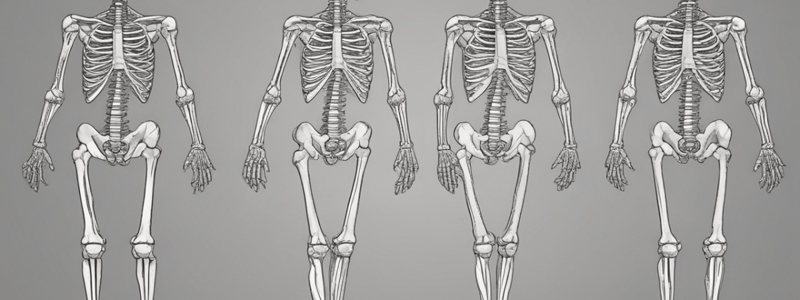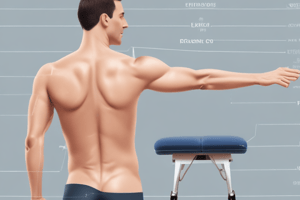Podcast
Questions and Answers
What is the primary indication for Interlaced Digital/Proximal Humerus technique in flexion?
What is the primary indication for Interlaced Digital/Proximal Humerus technique in flexion?
- Superior misalignment of the scapula
- Inferior misalignment of the humerus
- Loss of accessory movements in superior glide in flexion
- Loss of accessory movements in inferior glide in flexion (correct)
In the patient positioning for Interlaced Digital/Proximal Humerus in flexion, what is the angle of elbow flexion?
In the patient positioning for Interlaced Digital/Proximal Humerus in flexion, what is the angle of elbow flexion?
- 120 degrees
- 135 degrees
- 90 degrees (correct)
- 45 degrees
Where does the doctor stand in relation to the patient during Interlaced Digital/Proximal Humerus in flexion?
Where does the doctor stand in relation to the patient during Interlaced Digital/Proximal Humerus in flexion?
- To the side of the patient
- Behind the patient
- In front of the patient and to the affected side (correct)
- At an angle to the patient
What is the direction of the thrust in the Interlaced Digital/Proximal Humerus technique in flexion?
What is the direction of the thrust in the Interlaced Digital/Proximal Humerus technique in flexion?
What is the primary indication for Interlaced Digital/Proximal Humerus technique in abduction?
What is the primary indication for Interlaced Digital/Proximal Humerus technique in abduction?
How does the doctor grasp the proximal humerus in the Interlaced Digital/Proximal Humerus technique?
How does the doctor grasp the proximal humerus in the Interlaced Digital/Proximal Humerus technique?
What is the purpose of the downward pressure applied by the doctor's hands in the Interlaced Digital/Proximal Humerus technique?
What is the purpose of the downward pressure applied by the doctor's hands in the Interlaced Digital/Proximal Humerus technique?
In what direction does the doctor step away from the patient during the Interlaced Digital/Proximal Humerus technique in abduction?
In what direction does the doctor step away from the patient during the Interlaced Digital/Proximal Humerus technique in abduction?
The doctor's thumbs are placed on the superior aspect of the joint capsule during the Interlaced Digital/Proximal Humerus technique.
The doctor's thumbs are placed on the superior aspect of the joint capsule during the Interlaced Digital/Proximal Humerus technique.
The patient's arm is fully abducted to 180 degrees during the Interlaced Digital/Proximal Humerus technique in abduction.
The patient's arm is fully abducted to 180 degrees during the Interlaced Digital/Proximal Humerus technique in abduction.
The Interlaced Digital/Proximal Humerus technique in flexion is used to treat inferior misalignment of the humerus.
The Interlaced Digital/Proximal Humerus technique in flexion is used to treat inferior misalignment of the humerus.
The doctor's legs should be crossed during the Interlaced Digital/Proximal Humerus technique in flexion.
The doctor's legs should be crossed during the Interlaced Digital/Proximal Humerus technique in flexion.
The patient's hand rests on the doctor's shoulder during the Interlaced Digital/Proximal Humerus technique in flexion.
The patient's hand rests on the doctor's shoulder during the Interlaced Digital/Proximal Humerus technique in flexion.
The doctor applies a lateral pressure to remove articular slack during the Interlaced Digital/Proximal Humerus technique.
The doctor applies a lateral pressure to remove articular slack during the Interlaced Digital/Proximal Humerus technique.
The Interlaced Digital/Proximal Humerus technique in abduction is used to treat loss of accessory movements in superior glide in abduction.
The Interlaced Digital/Proximal Humerus technique in abduction is used to treat loss of accessory movements in superior glide in abduction.
The doctor grasps the distal humerus with interlaced fingers during the Interlaced Digital/Proximal Humerus technique.
The doctor grasps the distal humerus with interlaced fingers during the Interlaced Digital/Proximal Humerus technique.
What is the primary indication for the Reinforced Palmar/Olecranon technique?
What is the primary indication for the Reinforced Palmar/Olecranon technique?
In what position does the patient place their hand during the Reinforced Palmar/Olecranon technique?
In what position does the patient place their hand during the Reinforced Palmar/Olecranon technique?
Where does the doctor stand in relation to the patient during the Reinforced Palmar/Olecranon technique?
Where does the doctor stand in relation to the patient during the Reinforced Palmar/Olecranon technique?
What is the role of the doctor's ipsilateral hand during the Reinforced Palmar/Olecranon technique?
What is the role of the doctor's ipsilateral hand during the Reinforced Palmar/Olecranon technique?
What is the primary direction of the thrust in the Reinforced Palmar/Olecranon technique?
What is the primary direction of the thrust in the Reinforced Palmar/Olecranon technique?
During the Reinforced Palmar/Olecranon technique, the patient's arm is fully abducted to 180 degrees.
During the Reinforced Palmar/Olecranon technique, the patient's arm is fully abducted to 180 degrees.
The doctor stands in front of the patient during the Reinforced Palmar/Olecranon technique.
The doctor stands in front of the patient during the Reinforced Palmar/Olecranon technique.
The doctor's contralateral hand is used to reinforce the contact point during the Reinforced Palmar/Olecranon technique.
The doctor's contralateral hand is used to reinforce the contact point during the Reinforced Palmar/Olecranon technique.
The thrust direction in the Reinforced Palmar/Olecranon technique is primarily in the axis of the radius.
The thrust direction in the Reinforced Palmar/Olecranon technique is primarily in the axis of the radius.
The contact point in the Reinforced Palmar/Olecranon technique is on the patient's shoulder.
The contact point in the Reinforced Palmar/Olecranon technique is on the patient's shoulder.
Flashcards are hidden until you start studying
Study Notes
Interlaced Digital/Proximal Humerus Techniques
Superior-to-Inferior Glide in Flexion
- Indicates loss of accessory movements in inferior glide in flexion and superior misalignment of the humerus
- Patient positioning: stands with feet shoulder-distance apart, involved arm flexed to 90 degrees, and elbow flexed so that hand rests on shoulder
- Doctor's positioning: stands in front of patient, legs spread for balance, and aligned to patient's height
- Contact points: proximal humerus, with interlaced fingers on superior aspect of joint capsule and thumbs in axilla
- Vectored correction: draw away from patient to create joint separation, then apply downward pressure to remove articular slack, and finally give a thrust in the superior-to-inferior direction
Superior-to-Inferior Glide in Abduction
- Indicates loss of accessory movements in inferior glide in abduction and superior misalignment of the humerus
- Patient positioning: stands with legs at least shoulder-distance apart, involved arm abducted to 90 degrees, and elbow flexed so that hand rests on shoulder
- Doctor's positioning: stands with legs apart, patient's elbow resting on doctor's shoulder
- Contact points: proximal humerus, with interlaced fingers on superior aspect and thumbs in axilla
- Vectored correction: back away from patient to distract joint while applying downward pressure with hands to remove articular slack, then give an impulse thrust in the superior-to-inferior direction
Interlaced Digital/Proximal Humerus Techniques
Superior-to-Inferior Glide in Flexion
- Indicates loss of accessory movements in inferior glide in flexion and superior misalignment of the humerus
- Patient positioning: stands with feet shoulder-distance apart, involved arm flexed to 90 degrees, and elbow flexed so that hand rests on shoulder
- Doctor's positioning: stands in front of patient, legs spread for balance, and aligned to patient's height
- Contact points: proximal humerus, with interlaced fingers on superior aspect of joint capsule and thumbs in axilla
- Vectored correction: draw away from patient to create joint separation, then apply downward pressure to remove articular slack, and finally give a thrust in the superior-to-inferior direction
Superior-to-Inferior Glide in Abduction
- Indicates loss of accessory movements in inferior glide in abduction and superior misalignment of the humerus
- Patient positioning: stands with legs at least shoulder-distance apart, involved arm abducted to 90 degrees, and elbow flexed so that hand rests on shoulder
- Doctor's positioning: stands with legs apart, patient's elbow resting on doctor's shoulder
- Contact points: proximal humerus, with interlaced fingers on superior aspect and thumbs in axilla
- Vectored correction: back away from patient to distract joint while applying downward pressure with hands to remove articular slack, then give an impulse thrust in the superior-to-inferior direction
Reinforced Palmar/Olecranon; Anterior-to-Posterior Glide
- IND: Loss of A-P accessory movement, anterior misalignment of the humerus
- PP: Patient positioning involves sitting with arm in forward flexion, elbow bent, and hand resting on opposite shoulder (for internal rotation) or same shoulder (for external rotation)
Procedure Details
- DP: Stand behind patient, slightly to the side of involvement, stabilizing shoulder girdle against torso
- SCP: Olecranon process
- CP: Palmar contact to cup patient's elbow using ipsilateral hand
- IH: Reinforcing CP with other hand
- VEC: A-P direction
- P: Remove articular slack, give quick and shallow thrust primarily in humerus axis using both hands
Reinforced Palmar/Olecranon; Anterior-to-Posterior Glide
- IND: Loss of A-P accessory movement, anterior misalignment of the humerus
- PP: Patient positioning involves sitting with arm in forward flexion, elbow bent, and hand resting on opposite shoulder (for internal rotation) or same shoulder (for external rotation)
Procedure Details
- DP: Stand behind patient, slightly to the side of involvement, stabilizing shoulder girdle against torso
- SCP: Olecranon process
- CP: Palmar contact to cup patient's elbow using ipsilateral hand
- IH: Reinforcing CP with other hand
- VEC: A-P direction
- P: Remove articular slack, give quick and shallow thrust primarily in humerus axis using both hands
Studying That Suits You
Use AI to generate personalized quizzes and flashcards to suit your learning preferences.




